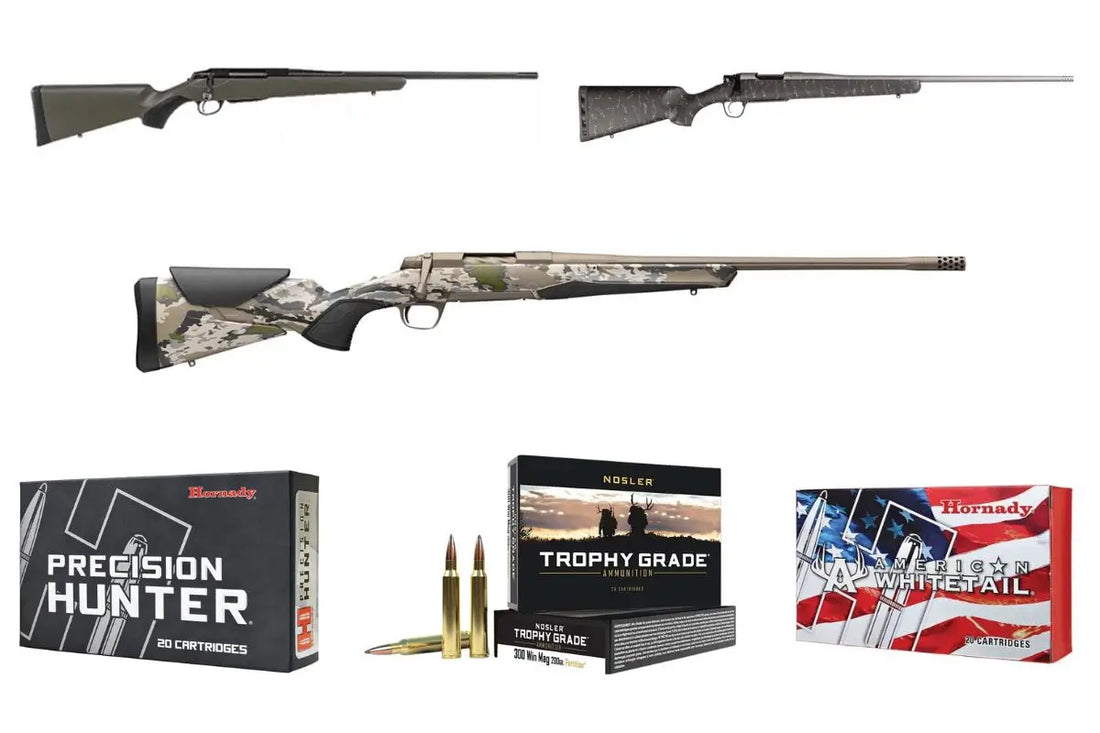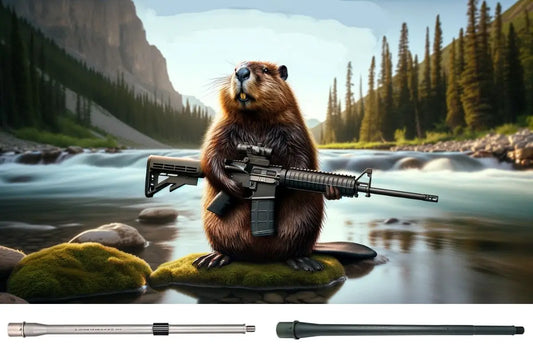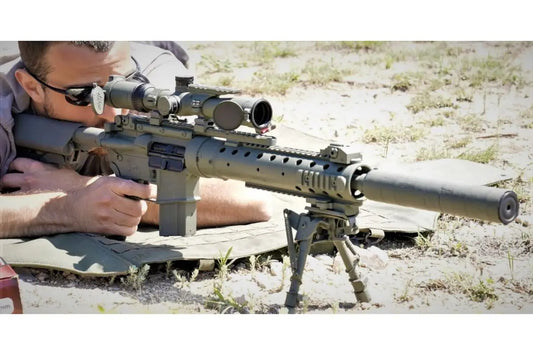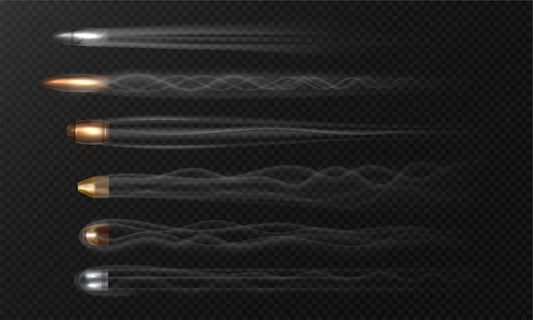
300 Win Mag vs. the Upstarts: Does the Old King Still Rule Long-Action Hunting?
Fast Summary Table (for quick comparisons)
|
Cartridge |
Typical factory load (test barrel) |
Approx. G1/G7 BC (example bullet) |
Recoil (9-lb rifle, calc.) |
SAAMI/CIP COAL |
One-line take |
|
.300 Win Mag |
200gr ELD-X @ ~2850 fps |
~0.626 / 0.315 (Hornady ELD-X 200gr) |
~30 ft-lb (calc., see text) |
3.340" COAL (SAAMI) |
The most versatile, most available long-action hammer for North America. Constrained by legacy geometry. |
|
.300 PRC |
212gr ELD-X @ ~2860 fps |
~0.673 / 0.336 (Hornady ELD-X 212gr) |
~33 ft-lb (calc.) |
3.700" COAL (SAAMI) |
Purpose-built for modern heavy, high-BC .30 bullets; excellent long-range design. |
|
.28 Nosler |
175gr ABLR @ ~3125 fps |
~0.648 / 0.326 (Nosler ABLR 175gr) |
~31 ft-lb (calc.) |
3.340" COAL (SAAMI) (standard long-action) |
Blistering 7mm speed with efficient BC; pays in powder and (often) barrel life. |
|
7mm PRC |
175gr ELD-X @ ~3000 fps |
~0.689 / 0.347 (Hornady 175 ELD-X) |
~24–26 ft-lb (est.) |
3.340" COAL (SAAMI) |
The “Goldilocks” modern long-action for elk/deer with less recoil than .30 cals. |
|
6.5 Creedmoor (context) |
143gr ELD-X @ ~2700 fps |
~0.625 / ~0.315 (Hornady/Federal) |
~12 ft-lb (calc. @ 9 lb; 7–18 ft-lb reported) |
2.825" COAL |
Minimal recoil, high hit probability; not a magnum elk hammer at distance. |
Jargon explainer: Ballistic coefficient and sectional density are worth a refresh if you haven’t looked lately—both drive long-range drop/wind and terminal performance.
TL;DR for Skimmers
- Yes— the .300 Win Mag is still the king of practical long-action hunting because it balances reach, authority, rifle choices, and ammo availability better than anything else.
- But— if your priority is running long, heavy, high-BC .30 bullets inside SAAMI and stretching precision past typical hunting distances, .300 PRC is the better designed monarch of the modern era. .28 Nosler and 7mm PRC split the difference with flatter flight / less recoil, respectively.
The Case for .300 Win Mag (1963–Today)
The .300 Win. Mag. earned its crown by doing almost everything well: a flat 500-yard zero game-gun, authority on elk, moose, and bear, and broad rifle and ammo availability from big-box shelves to backcountry posts. Introduced in 1963, it’s a belted .30 that stuffs serious powder under 180–200gr bullets and pushes them around ~3,000 fps, delivering the energy and wind performance hunters wanted long before “ELD,” “LR,” and “PRS” were industry acronyms.
It’s no coincidence military and LE snipers leaned on it for years (MK248 ammunition, long-range interdiction use), which helped cement its reputation as a do-it-all 30-cal magnum that just works.
Real-world, in-stock loads that define the .300 Win Mag lane
- Hornady Precision Hunter 200gr ELD-X (~2850 fps, high BC hunting load).
- Federal Terminal Ascent 200gr (~2810 fps; bonded, long-range capable).
- Barnes VOR-TX LR 190gr LRX (~2880 fps; mono, deep penetration).
- “Bread-and-butter” deer/elk fodder like Remington Core-Lokt 180gr (2960 fps) and Winchester Deer Season XP 150gr (fast, flat) remain widely available and affordable.
Translation: Whatever you hunt and wherever you shop, .300 Win Mag ammo is there—from premium elk loads to economy deer bullets. That everyday availability still matters in 2025.
Where the Old King Shows His Age
Two technical constraints keep coming up:
- Belted case, shoulder design, and throat geometry. The legacy belt headspaces forward of the extractor groove instead of the modern shoulder datum. Hornady ballisticians (and others) have explained why belts are not ideal for peak precision, noting tolerance stack and bullet presentation into the rifling.
- Shorter SAAMI overall length (COAL)—3.340"—which can force long, heavy, high-BC bullets deep into the case, eating powder room and compromising consistency. As Outdoor Life puts it, very heavy .30 bullets (e.g., 220-grain+ classes) “won’t work well” in .300 Win Mag because they sit too far back in the case within standard magazines.
Those design realities don’t negate the .300 WM’s effectiveness; they simply narrow its optimal envelope compared to newer designs built explicitly for long, sleek bullets.
The Modern Challenger: .300 PRC
If .300 Win Mag is the all-terrain truck, .300 PRC is the same truck with a longer bed, better suspension geometry, and tires that actually match the terrain.
Hornady designed .300 PRC with today’s ultra-sleek bullets in mind: longer SAAMI COAL (3.700"), correct freebore and throat, and shoulder headspacing—so heavy 200–225gr class bullets can be seated without intruding deep into the case.
Hornady ballistician Jayden Quinlen summed up the why: “There has not been a SAAMI standardized, factory-produced cartridge that combines all of the attributes needed for long-range accuracy.”
Factory proof of concept is simple:
- .300 PRC Precision Hunter 212gr ELD-X (2860 fps), high-BC hunting load.
- .300 PRC 225gr ELD-Match (~2810 fps), stretching precision far beyond typical hunting distances.
Field/military signal: Early DoD interest and long-range “beyond 2,000 yards” capability press helped the PRC quickly gain legitimacy.
Net: If your hunting and practice commonly push past 500–800 yards and you tune heavy bullets for wind, .300 PRC’s geometry advantage is tough to ignore.
The Flatter 7mm Contenders: 7mm PRC & .28 Nosler
- 7mm PRC is the modern 7mm magnum we’ve wanted: 3.340" COAL, fast twists, long/heavy bullets, and ~3000 fps with a 175gr ELD-X, all while beating .30 cals in recoil and wind drift per unit recoil. In a mountain rifle, that matters.
- .28 Nosler is a hot-rod 7mm: 175gr ABLR at ~3125 fps with a legit .648 G1 BC—a hard combo to beat when you want flat + efficient. The trade is more powder and typically shorter barrel life if you shoot high volumes.
Recoil, Barrel Life, and Practical Shootability
Recoil (apples-to-apples): Using a standard free-recoil formula and a 9-lb scoped rifle, representative loads pencil out roughly as follows:
- .300 Win Mag, 200 @ 2850: ~30 ft-lb
- .300 PRC, 212 @ 2860: ~33 ft-lb
- .28 Nosler, 175 @ 3125: ~31 ft-lb
- 7mm PRC, 175 @ 3000: ~25 ft-lb (est.)
- 6.5 Creedmoor, 143 @ 2700: ~12 ft-lb (many sources report ~7–18 ft-lb depending on rifle weight).
Barrel life: Real shooters’ logs and editorial guidance converge on ~1,000–1,500 rounds for hot .300 magnums (faster if abused; longer if cool and sensible), 2,500–3,000+ for 6.5 CM, and ~1,000–1,600 for .300 PRC depending on expectations. This varies wildly with heat, load, and cleaning. For a hunting rifle, you’re unlikely to burn a tube out soon; for high-volume practice, bolt on a brake/suppressor and mind heat.
What Does This Mean in the Field?
Elk/Moose/Bear (0–500 yards):
- If you want maximum availability, simple choices, and forgiving terminal performance: .300 Win. Mag. with 180–200gr bonded or controlled-expansion bullets remains a fantastic, proven default. Think Federal 200gr Terminal Ascent, Barnes 190 LRX, Core-Lokt 180gr.
Windy basins, long cross-canyon shots (500–900+ yards, with practice/ethics caveats):
- .300 PRC (212–225gr ELD-X/M) shines because its bullet seating and throat are built around high-BC heavies that hold velocity and buck wind—with less hassle than stretching .300 WM inside mag-length boxes.
- .28 Nosler prints the flattest arcs with the right 7mm pills but demands powder and patience (and a longer tube) for best results.
Recoil-sensitive or ultralight mountain rigs:
- 7mm PRC splits the difference: impactful elk performance with milder recoil, easy access to sleek 7mm bullets, and long-action compatibility.
Rifles Worth Buying (by use case)
All-around .300 Win Mag hunting rifles (light to general-purpose):
- Tikka T3x Lite / Superlite—accurate, light, threaded options, great triggers; a backcountry staple.
- Browning X-Bolt 2 Speed / Speed Long Range—modern ergonomics, light cans/brakes, great out-of-box accuracy.
- Winchester Model 70 Extreme Weather SS—CRF action and stainless, a classic mountain rifle that actually lives outdoors.
- Bergara B-14 HMR—if you want a crossover stock, adjustable cheek, and repeatable bedding that also hunts.
- Christensen Arms Mesa / Mesa FFT—lightweight, threaded, and backed by a sub-MOA guarantee; FFT shaves ounces.
Precision-leaning .300 PRC rigs (heavy bullets, longer ranges):
- Savage 110 Precision / Elite Precision (.300 PRC)—MDT chassis, AccuTrigger, 20-MOA rail; excellent entry to true LR ergonomics.
- Bergara Wilderness Ridge (300 PRC)—a hunting-weight PRC with a good barrel and muzzle brake out of the box.
- Ruger Hawkeye Long-Range Target—CRF style action in a stable laminate/chassis-ish stock; also offered in .300 Win Mag.
(Pro tip: regardless of chambering, prioritize a good brake or a suppressor and a consistent, torqued mounting system. Your hit percentage goes up when you see your own impacts.)
Ballistics: Why Geometry Matters in 2025
What changed since 1963? Bullet design and our understanding of external ballistics. We’re all shooting heavier-for-caliber, very-low-drag bullets because BC pays compound interest downrange (less drop, less wind), and heavy bullets keep momentum for reliable terminal performance.
- .300 Win Mag can absolutely run 200–210gr bullets well. But when you move to 220–230gr and beyond, magazine length + throat often force deep seating or single-loading solutions that erode consistency. Outdoor Life explicitly calls out why very heavy .30s are awkward in .300 Win Mag.
- .300 PRC was explicitly dimensioned to avoid those constraints: long COAL, the right freebore, and shoulder headspacing to seat long, heavy bullets correctly and maintain case capacity. The RECOIL deep dive with Hornady’s ballisticians explains the design choices (and the move to ditch the belt).
Pros & Cons (be brutally honest)
.300 Win Mag
Pros
- Everywhere, always: ammo on shelves in multiple price tiers; rifles from budget to heirloom.
- Proven terminal performance on big game across North America.
- Strong factory load ecosystem (bonded, copper, match-style hunting).
Cons
- Legacy geometry: belt headspacing and 3.340" COAL limit very heavy .30 bullets inside mag length.
- Recoil that often nudges past 30 ft-lb in realistic hunting weights if you don’t brake or can it (training suffers if you hate practice).
- Peak precision at extreme range lags newer designs unless you re-throat, single-feed, or go custom.
.300 PRC
Pros
- Engineered for long-range precision with 3.700" COAL and modern throat; takes 200–225gr heavies in stride.
- Outstanding downrange ballistics with common factory loads (212gr ELD-X, 225gr ELD-M).
- Growing rifle/ammo support from major makers.
Cons
- More recoil than .300 Win Mag, in like-for-like weight (a few ft-lb more).
- Ammo not as ubiquitous everywhere as .300 Win Mag (though easy to web-order).
.28 Nosler
Pros
- Speed + BC in 7mm gives fantastic drop/wind numbers; elk-capable with excellent bullets (175 ABLR).
- Standard long-action footprint makes it accessible in many platforms.
Cons
- Powder-hungry; tends to eat barrels faster if pushed and shot hot.
- Ammo availability can be spotty outside specialty retailers.
7mm PRC
Pros
- Modern design benefits similar to .300 PRC but with less recoil and excellent 7mm bullet selection.
- Great elk/deer axis in lightweight rifles.
Cons
- Newer ecosystem than .300 Win Mag (but growing quickly).
So… Is .300 Win Mag still the king?
Short answer: Yes—of practicality. If you define “king” by broad ammo on shelves, proven performance across all big-game classes, and a huge rifle catalog, .300 Win Mag still wears the crown. It’s the cartridge most likely to get you shooting right now with minimal hassle and maximum confidence.
Long answer: For pure, modern long-range design, .300 PRC is the superior .30-cal architecture, hands down—longer COAL, correct throat, shoulder headspacing, purpose-built for heavy, high-BC bullets. If your hunts and practice emphasize wind and consistency past 600–800 yards, a PRC-chambered rig is the better bet.
Contrarian (and increasingly common) view: Many elk hunters are concluding a 7mm PRC or a well-built .28 Nosler brings similar lethality with less punishment and flatter flight. If you carry under 7 lb and hike at elevation, that recoil/weight calculus matters.
Highly Vetted Product Picks (top-shelf examples)
.300 Win Mag rifles
- Tikka T3x Lite/Superlite—legit sub-MOA out of the box, threaded, ~6.4 lb (Lite). Add a small brake or can and go hunt.
- Browning X-Bolt 2 Speed / Speed Long Range—adjustable stock geometry, threaded barrels, solid factory brakes; “new-school” ergonomics.
- Winchester Model 70 Extreme Weather SS—CRF, Bell & Carlson stock, stainless/fluted—made for real weather.
- Bergara B-14 HMR—if you want a crossover that also rides a bipod beautifully.
- Christensen Arms Mesa / Mesa FFT—light, threaded, carbon tech; hunting rifles that behave like customs.
.300 PRC rifles
- Savage 110 Precision / Elite Precision—MDT chassis, AccuTrigger, AICS mags; credible long-range starter platforms.
- Bergara Wilderness Ridge (300 PRC)— “hunting weight” PRC with a good barrel and brake from the factory.
Signature factory loads
- .300 Win Mag: Hornady 200gr ELD-X (Precision Hunter), Federal 200gr Terminal Ascent, Barnes 190 LRX (VOR-TX LR).
- .300 PRC: Hornady 212gr ELD-X (2860 fps), 225gr ELD-Match (2810 fps).
- .28 Nosler: 175gr AccuBond LR (~3125 fps).
- 7mm PRC: 175gr ELD-X (~3000 fps).
A Few Numbers and Nuance (because details win hunts)
- COAL realities: .300 Win Mag’s 3.340" COAL vs .300 PRC’s 3.700" looks like a small delta on paper; in practice it’s the difference between cramming a 225gr .30 into your powder stack vs seating it properly. That matters for SD and ignition consistency, which drive vertical dispersion downrange.
- Wind is the boss: Heavy, high-BC bullets (whether .30 or 7mm) cut wind drift—the #1 killer of hits at distance. That’s why PRC geometry (both 7mm and .300) feels like it “punches up” for its recoil class.
- Recoil you can train with: At ~30–33 ft-lb unbraked, the big .30s are perfectly manageable with a light brake or a suppressor, and your spot-your-own-impact rate skyrockets. (The Browning X-Bolt and Bergara Wilderness rifles ship with brakes; many Tikkas/Christensens are threaded from the factory.)
Pull-No-Punches Verdict
- If you want one rifle to hunt anything in North America with readily available ammo, minimal logistics, and decades of proven results, stick with .300 Win Mag.
- If your ethos is long-range precision first, and you regularly dial/hold in real wind, .300 PRC is the smarter architecture.
- If you’re recoil-averse or carrying ultralight but still chasing elk at range, 7mm PRC gives you a remarkably capable middle path.
- If you crave 7mm flatness and sizzle, and you’re comfortable managing barrel heat and component sourcing, .28 Nosler absolutely performs.
Our opinionated take: .300 Win Mag remains the king of practical long-actions. .300 PRC is the king of modern design. Buy the crown that matches how (and how far) you actually hunt.
Buy .300 Win Mag or .300 PRC rifles & ammunition at SCHEELS.com.
Sources & Expert Notes (selected)
- Design & quotes on PRC intent, belt headspacing drawbacks, and 3.70" COAL: RECOIL feature with Hornady ballisticians.
- COAL numbers for .300 WM (3.340") and .300 PRC (3.700"): Outdoor Life.
- Heavy-bullet limitations in .300 WM (mag length seating): Outdoor Life.
- Military use of .300 Win. Mag. & MK248: Wikipedia overview (with sourcing).
- Factory ammo exemplars and velocities: Hornady, Federal, Barnes, Nosler product pages.




